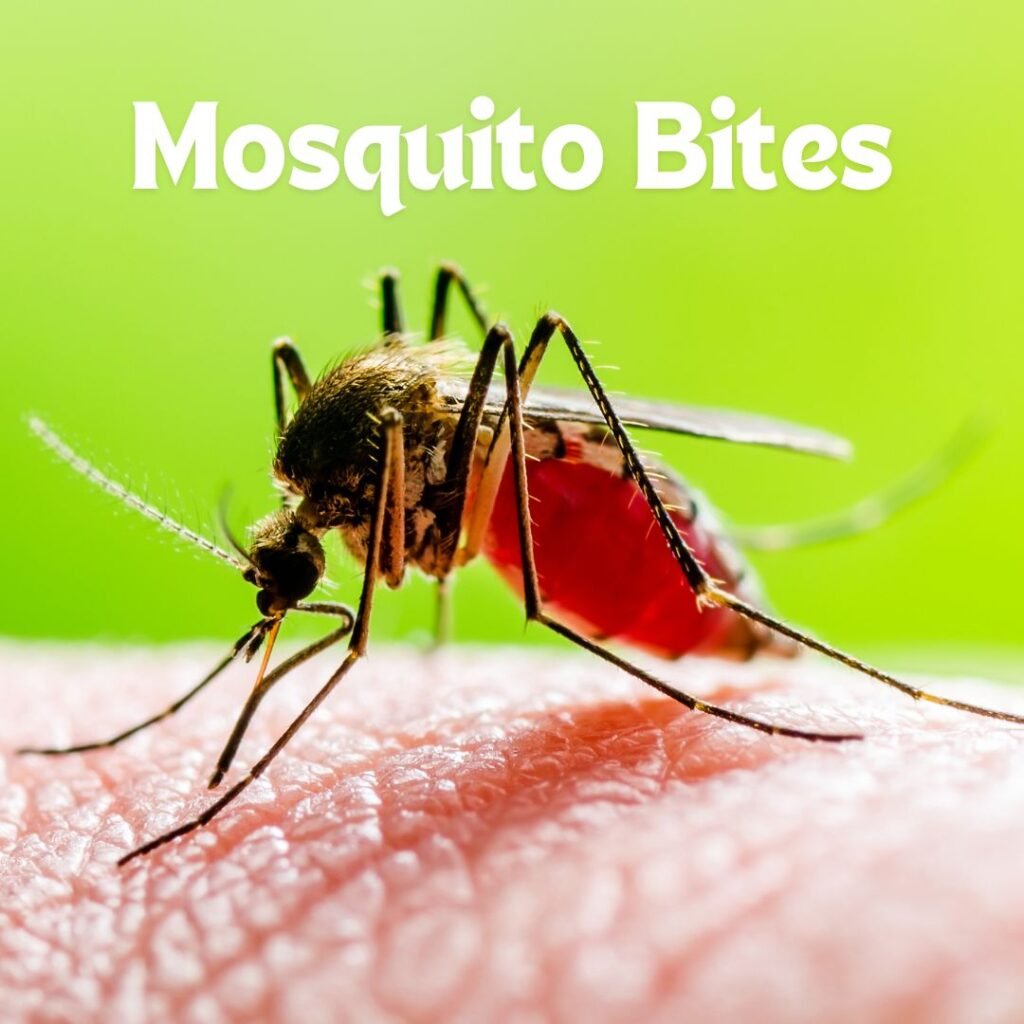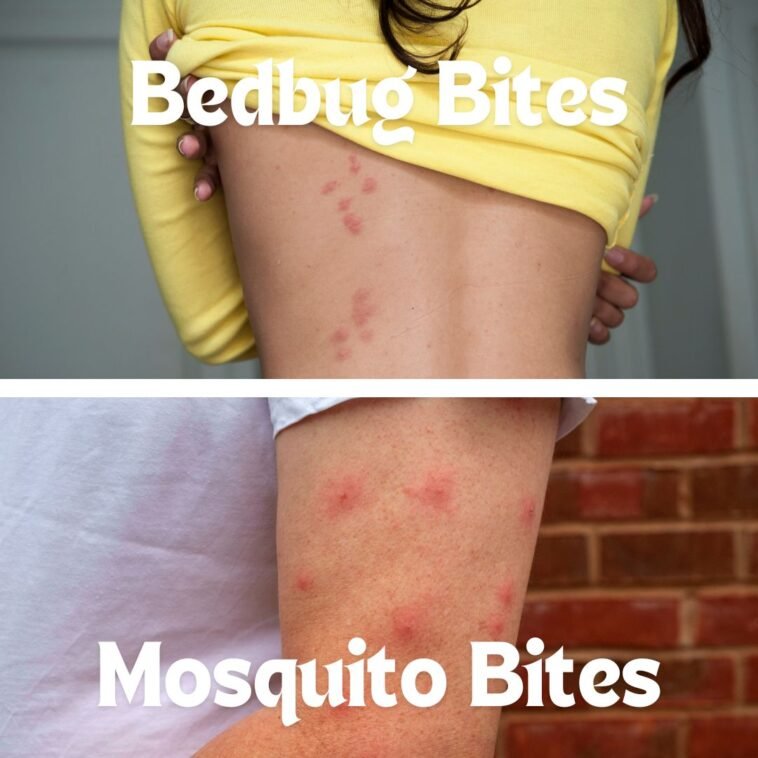Waking up to itchy, red bites on your skin can be unsettling, especially when you’re unsure of the cause. Are these bites from a bedbug, a mosquito, or perhaps some other insect? Insects such as bedbugs and mosquitoes are common culprits behind these irritating marks, but understanding the differences between their bites is crucial for proper identification and treatment.
In this comprehensive guide, we’ll explore the distinguishing characteristics of bedbug bites, mosquito bites, and other insect bites like those from fleas and spiders. Through detailed descriptions, comparison pictures, and expert advice, you’ll gain a better understanding of how to tell these bites apart and how to treat them effectively.
Table of Contents
- The Basics of Bedbug Bites
- What Do Bedbug Bites Look Like?
- Mosquito Bites: How They Differ from Bedbug Bites
- Other Insect Bites to Consider
- How to Treat Bedbug Bites
- How to Get Rid of Bedbugs
- Understanding the Risks of Bedbug Bites
- Distinguishing Bedbug Bites from Other Conditions
The Basics of Bedbug Bites
Bedbugs are small, parasitic insects that feed on the blood of humans and animals. They are most active at night and prefer to hide in cracks and crevices during the day, making them difficult to detect. Bedbugs are notorious for their ability to spread rapidly, hitching rides in luggage, clothing, and even furniture.
Bedbug bites are not just a nuisance; they can also lead to secondary skin infections due to scratching and may cause allergic reactions in some individuals. Understanding the specific characteristics of bedbug bites can help you identify them more quickly and take appropriate action.
What Do Bedbug Bites Look Like?
Bedbug bites can appear differently on various skin tones, but they generally share some common characteristics. On lighter skin, bedbug bites often look like small, smooth, raised bumps that are red or pink. On darker skin, the bumps may be harder to see and might appear skin-colored, violet, or brown. After the bites heal, they can leave behind dark marks known as post-inflammatory hyperpigmentation, which can take months to fade.
Typically, bedbug bites are very itchy, and their appearance can vary based on the individual’s reaction to the bite. Some people might only have a few bites, while others could develop clusters of bites that are intensely itchy and may become scratched or crusty.
Common Patterns and Locations
One of the most telling signs of bedbug bites is their pattern. Bedbug bites are usually grouped together in clusters of three to five bites and can form a straight line or a zigzag pattern. This pattern occurs because bedbugs tend to bite multiple times as they move across your skin during their feeding.
The bites often appear on areas of the body that are exposed while you sleep, such as the arms, legs, neck, and face. Bedbugs are less likely to bite through clothing, so bites found on covered areas of the body are less likely to be from bedbugs.
Mosquito Bites: How They Differ from Bedbug Bites

Mosquitoes are another common source of insect bites, especially during the warmer months. Unlike bedbugs, mosquitoes are active during the day and evening, making them more likely to bite when you’re outdoors. Mosquito bites can be irritating, but they also carry the risk of transmitting diseases like malaria, dengue fever, and West Nile virus in certain parts of the world.
Appearance of Mosquito Bites
Mosquito bites can look similar to bedbug bites at first glance, but there are some differences. On lighter skin, mosquito bites appear as smooth, round, raised bumps that are usually red or pink. On darker skin, they may appear skin-colored, violet, or brown. The bites are typically smaller than bedbug bites and are less likely to occur in clusters.
One key difference is that mosquito bites are usually isolated or occur in a random pattern rather than in clusters or lines. This random distribution is due to mosquitoes biting and moving on rather than feeding multiple times in one area like bedbugs.
Common Locations and Timing
Mosquito bites usually occur on exposed skin, particularly areas like the arms, legs, and face. Unlike bedbugs, mosquitoes do not discriminate based on clothing, as they can bite through thin fabrics. Mosquito bites are more common during the summer and fall months, especially in regions with a warm climate.
Mosquitoes are attracted to warmth, carbon dioxide, and certain scents, which is why they tend to bite people who are active outdoors, sweating, or using scented products.
Other Insect Bites to Consider
While bedbug and mosquito bites are among the most common insect bites people experience, other insects like fleas and spiders can also leave similar marks on the skin. Understanding the differences in appearance and behavior of these bites can help you further narrow down the cause of your symptoms.
Flea Bites
Fleas are tiny, wingless insects that often live on pets like dogs and cats. They can also infest homes, particularly carpets and upholstered furniture. Flea bites are typically small, itchy bumps that appear in clusters, much like bedbug bites, but they are usually concentrated around the lower legs, feet, and ankles.
One of the distinguishing features of flea bites is their tendency to appear in rows or clusters around areas where clothing fits tightly, such as around the waistband, sock lines, or under tight clothing. Flea bites can also cause allergic reactions in some individuals, leading to more severe itching and redness.
Visual Comparison of Flea Bites
- Flea Bite Example: Many tiny flea bites around the ankle and lower leg, appearing as small, red bumps.
- Flea Bite Example: Flea bites around the waist with post-inflammatory hyperpigmentation, showing as brown or violet patches on darker skin tones.
Spider Bites
Spider bites are less common than bites from bedbugs, mosquitoes, or fleas, but they can still occur. Most spiders in the United States are harmless, and their bites typically cause minor symptoms. However, certain species, like the black widow or brown recluse, can cause more serious reactions.
A spider bite often appears as a single, smooth bump on the skin, which may be red (on lighter skin) or violet/brown (on darker skin). The bite may have a central puncture mark, and in some cases, it may develop a crust or blister. More severe spider bites can cause open sores, significant swelling, or dark-red or brown color changes in the skin.
Visual Comparison of Spider Bites
- Spider Bite Example: A single spider bite on the forehead, appearing as a smooth bump with a central mark.
- Spider Bite Example: A spider bite on the cheek with a central crust, indicating a more severe reaction.
How to Treat Bedbug Bites
If you suspect that you’ve been bitten by bedbugs, it’s important to take steps to alleviate the symptoms and prevent secondary infections. While there is no specific cure for bedbug bites, several treatments can help reduce discomfort and promote healing.
Over-the-Counter Treatments
- Steroid Creams: Over-the-counter hydrocortisone cream can help reduce itchiness, swelling, and redness associated with bedbug bites. Apply the cream as directed on the affected area.
- Antihistamines: Oral antihistamines, such as loratadine (Claritin) or diphenhydramine (Benadryl), can help alleviate itching and reduce the allergic reaction to the bites.
- Oatmeal Baths: Taking an oatmeal bath can soothe irritated skin and reduce itching. Colloidal oatmeal products are available in most pharmacies and can be added to bathwater for relief.
- Cold Compresses: Applying a cold compress or ice pack to the affected area can help reduce swelling and numb the skin, providing temporary relief from itching.
- Loose Clothing: Wearing loose, breathable fabrics like cotton can help prevent further irritation of the skin and allow the bites to heal more quickly.
Preventing Secondary Infections
Bedbug bites can become infected if scratched excessively, so it’s crucial to keep the affected area clean. Wash the bites with soap and water regularly to remove bacteria and prevent infection. If you notice signs of infection, such as increased redness, warmth, swelling, or pus, seek medical attention promptly.
How to Get Rid of Bedbugs
Dealing with a bedbug infestation can be challenging, especially because these pests are resistant to many common pesticides. If you suspect that bedbugs are present in your home, taking immediate action is essential to prevent the infestation from spreading.
Professional Pest Control
The most effective way to eliminate bedbugs is to hire a professional pest control company with experience in treating bedbug infestations. Professionals have access to stronger pesticides and specialized equipment that can target bedbugs in hard-to-reach areas. They can also provide advice on preventing future infestations.
DIY Methods for Bedbug Control
If you prefer to try eliminating bedbugs on your own, several steps can help reduce their population:
- Wash Bedding and Clothing: Wash all bed linens, clothing, and other washable items in hot water for at least 30 minutes. Then, dry them on the highest heat setting for at least 30 minutes to kill bedbugs and their eggs.
- Declutter Your Room: Remove excess clutter from the room to reduce hiding spots for bedbugs. However, be careful not to spread bedbugs to other areas of your home by moving infested items.
- Vacuum Regularly: Vacuum your mattress, bed frame, baseboards, and any upholstered furniture thoroughly. Use a vacuum with a HEPA filter to capture bedbugs and their eggs. Dispose of the vacuum bag immediately after use.
- Use Mattress and Pillow Covers: Encase your mattress and pillows in protective covers designed to prevent bedbugs from entering or escaping. This can help contain the infestation and prevent bites while you sleep.
- **Freeze Non
-Washable Items**: For items that cannot be washed, such as books, shoes, or toys, place them in a sealed plastic bag and store them in the freezer for at least three days. The cold temperature will kill any bedbugs or eggs.
- Use Bedbug Traps: Bedbug traps can be placed under bed legs to catch any bedbugs attempting to climb onto the bed. While traps alone won’t eliminate an infestation, they can help monitor the severity of the problem.
- Apply Bedbug-Specific Sprays: Several over-the-counter sprays are formulated specifically to kill bedbugs. These sprays can be applied to mattresses, bed frames, and other areas where bedbugs are likely to hide. Be sure to follow the instructions carefully and use sprays that are safe for indoor use.
Long-Term Prevention
Preventing bedbugs from returning after an infestation is crucial to maintaining a bedbug-free home. Here are some tips for long-term prevention:
- Inspect Second-Hand Items: Before bringing second-hand furniture, clothing, or other items into your home, inspect them thoroughly for signs of bedbugs. Pay close attention to seams, crevices, and folds where bedbugs may hide.
- Be Cautious While Traveling: Bedbugs are excellent hitchhikers and can easily travel from hotels to your home. When staying in hotels, inspect the mattress, headboard, and furniture for signs of bedbugs. Keep your luggage off the floor and away from the bed, and wash your clothes immediately upon returning home.
- Seal Cracks and Crevices: Bedbugs can hide in cracks and crevices in walls, baseboards, and furniture. Sealing these gaps can reduce potential hiding spots and make it more difficult for bedbugs to establish a presence in your home.
- Regularly Inspect Your Home: Even after an infestation has been treated, continue to inspect your home regularly for signs of bedbugs. Early detection is key to preventing a full-blown infestation.
Understanding the Risks of Bedbug Bites
While bedbug bites are generally not dangerous, they can cause discomfort and, in some cases, lead to more serious health issues. It’s important to be aware of the potential risks associated with bedbug bites so that you can take appropriate action if necessary.
Allergic Reactions
Some people may have an allergic reaction to bedbug bites, leading to more severe symptoms such as intense itching, swelling, and redness. In rare cases, individuals may develop hives or experience anaphylaxis, a life-threatening allergic reaction that requires immediate medical attention.
If you notice that your bedbug bites are causing an unusual amount of swelling or discomfort, or if you experience difficulty breathing, seek medical help right away.
Secondary Infections
Scratching bedbug bites can break the skin, creating an entry point for bacteria. This can lead to secondary infections, which may require antibiotic treatment. Signs of infection include increased redness, warmth, swelling, pus, or red streaks extending from the bite.
To prevent infection, avoid scratching the bites and keep the affected area clean. Applying an antiseptic cream or ointment can also help reduce the risk of infection.
Mental Health Impact
Dealing with a bedbug infestation can be stressful and may impact your mental health. The thought of being bitten while you sleep can cause anxiety, insomnia, and even depression. If you’re struggling with the emotional impact of a bedbug infestation, consider speaking with a mental health professional who can provide support and coping strategies.
Distinguishing Bedbug Bites from Other Conditions
In addition to insect bites, several skin conditions can cause symptoms similar to bedbug bites. It’s important to consider these conditions when diagnosing the cause of your symptoms.
Dermatitis
Dermatitis is a general term for skin inflammation that can be caused by allergies, irritants, or other factors. It often presents as red, itchy patches on the skin, which can resemble bedbug bites. However, dermatitis typically does not follow the distinct patterns associated with bedbug bites and may affect larger areas of the skin.
Hives
Hives, also known as urticaria, are raised, itchy welts that can appear suddenly on the skin. They can be triggered by allergies, stress, or other factors. Unlike bedbug bites, hives often come and go quickly and may appear in various locations on the body. Hives do not usually follow the clustered or linear patterns typical of bedbug bites.
Scabies
Scabies is a skin condition caused by tiny mites that burrow into the skin, causing intense itching and a pimple-like rash. The rash may resemble bedbug bites but is often more widespread and can appear on parts of the body not typically affected by bedbugs, such as the hands, feet, and groin.
Scabies requires medical treatment with prescription medications, so it’s important to see a doctor if you suspect you have scabies.
Takeaway
Distinguishing between bedbug bites and other insect bites is essential for identifying the source of your discomfort and taking the appropriate steps to address it. By understanding the unique characteristics of bedbug bites, including their appearance, patterns, and common locations, you can better determine whether bedbugs are the cause of your symptoms.
If you suspect a bedbug infestation, taking prompt action to treat the bites and eliminate the pests is crucial. While over-the-counter treatments can help alleviate the symptoms of bedbug bites, professional pest control may be necessary to completely eradicate the infestation.
By staying informed about the signs of bedbug bites and the steps to prevent and treat infestations, you can protect your home and your health from these unwelcome intruders.
Please Subscribe Us to get updated with Qatar News, Saudi News, Kuwait News, Health News, UAE News, Iqama, Visa, Jobs, Banking and More.



